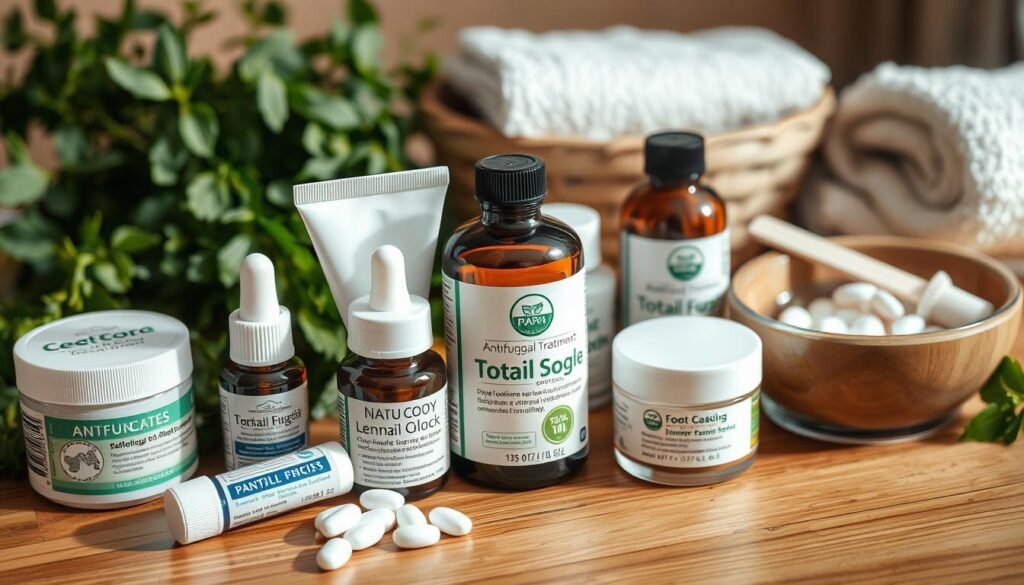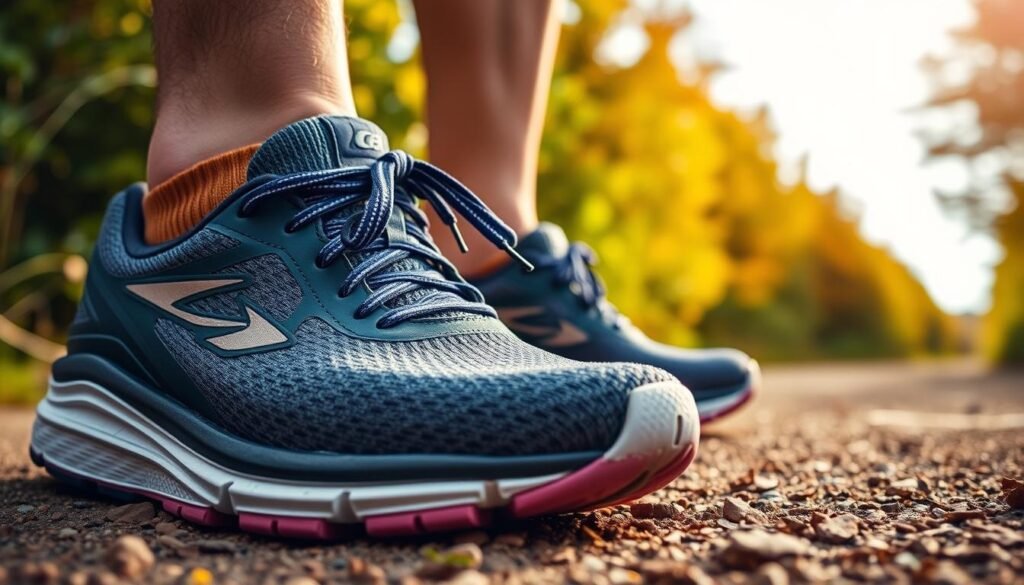Running has been my passion for years, but nothing prepared me for the silent battle brewing beneath my toenails. Like many runners, I discovered the challenging world of runners toenail fungus – a condition that can sideline even the most dedicated athlete.
Up to 12% of recreational runners experience toenail fungal infection during their running careers. This persistent problem isn’t just a cosmetic issue – it can significantly impact your performance and foot health. We understand the frustration and discomfort runners face when dealing with this stubborn condition.
Our guide will help you understand, treat, and prevent runners toenail fungus. We’ll cover identifying early symptoms and exploring both medical and natural treatment options. Our goal is to help you keep your feet healthy and your running routine uninterrupted.
Key Takeaways
- Runners toenail fungus affects up to 12% of recreational runners
- Early detection is key for effective treatment
- Proper foot hygiene can significantly reduce infection risk
- Both medical and natural treatment options are available
- Prevention strategies are key to maintaining foot health
- Moisture-wicking socks can decrease fungal toenail incidence by 60%
Understanding Runners Toenail Fungus: Causes and Risk Factors
Runners face unique challenges with foot health, like fungal nail infections. Toenail fungus can really affect their performance and foot health.
Several key factors make it hard for runners to fight athlete’s foot and nail fungus:
Common Causes of Fungal Infections
- Mechanical pressure from tight running shoes
- Constant moisture trapped in footwear
- Micro-injuries from repetitive running movements
- Inadequate foot hygiene practices
Who is Most at Risk
Some runners are more likely to get fungal nail infections. The main risk groups are:
- Runners over 40 with decreased circulation
- Athletes with compromised immune systems
- Individuals with pre-existing foot conditions
- Runners who frequently experience nail trauma
Environmental Factors
Fungal growth loves certain conditions. Runners often find themselves in these high-risk spots:
- Warm, damp shoe interiors
- Public shower and locker room spaces
- Sweaty socks and prolonged moisture exposure
Prevention is always more effective than treatment when managing fungal nail infections.
Knowing these risks helps runners take steps to prevent fungal nail infections. This way, they can keep their feet healthy and perform better.
Identifying Early Signs and Symptoms
Spotting toenail fungus early is key for runners to avoid serious infections. About 14% of people get onychomycosis. It’s important to know the first signs.
The first signs of toenail fungus are often small. Runners might see a white, yellow, or brown spot under the nail tip. This small sign is painless but warns of a fungal problem.
- White or yellow discoloration of the nail
- Small spots developing near the nail tip
- Nail becoming brittle or crumbly
- Thickening of the nail
- Distorted nail shape
Preventing nail fungus is vital for runners. They should watch for these symptoms. If ignored, the fungus can spread fast, affecting other nails.
“Early detection is key in managing toenail fungus effectively for athletes and runners.”
Runners with diabetes, past fungal infections, or frequent injuries need to be careful. The risk of toenail fungus goes up with age. Regular nail checks are a must.
If your toenails keep changing, see a doctor. Early action can stop worse damage and shorten treatment time.
The Impact of Running on Toenail Health
Running can be tough on your toenails. Every step causes tiny damage that adds up over time. This can lead to serious problems with your toenails. It’s important for runners to know how to protect their feet and keep their toenails healthy.
Microtrauma and Nail Damage
Runners’ toes hit the inside of their shoes with each step. This creates microtrauma – tiny injuries that weaken the toenails. These injuries can make toenails more prone to fungal infections and damage.
- Big toe most commonly affected by running injuries
- Dark red or black toenails indicate possible damage
- Pain and pressure build-up under the nail
Repetitive Stress Effects
Runners face special challenges with their toenails. The constant pressure and friction can cause blood to pool under the nail. This can lead to nail loss. Using anti-fungal medication can help prevent these problems.
| Running Impact Factor | Potential Toenail Damage |
|---|---|
| Shoe Fit | Increases risk of microtrauma |
| Running Surface | Affects stress on toenails |
| Mileage | More miles = higher injury risk |
Prevention During Training
To protect your toenails, you need to take action. Here are some tips:
- Maintain a half-inch gap between toe and shoe end
- Use moisture-wicking socks
- Trim toenails properly to prevent injuries
- Select running shoes with adequate toe box space
“Prevention is always better than cure when it comes to runners’ toenail health.” – Sports Medicine Expert
Medical Treatment Options for Runners Toenail Fungus

Runners with toenail fungus have many medical options to fix their nails and stop the problem from getting worse. Our guide looks at the best ways to treat fungal nails for athletes.
Toenail fungus needs a specific treatment. There are different types of anti-fungal medicines, each with its own benefits for runners looking for relief.
Primary Treatment Approaches
- Oral Medications
- Topical Treatments
- Laser Therapy
- Surgical Interventions
Studies show that 80% of patients get better with oral antifungals. These medicines are taken by mouth and fight the fungus from the inside. They are more effective than treatments that just cover the nail.
| Treatment Type | Success Rate | Duration |
|---|---|---|
| Oral Medications | 70-80% | 3-6 months |
| Topical Treatments | 30-50% | 6-12 months |
| Laser Therapy | 60-75% | 1-3 sessions |
Runners should talk to doctors to find the best treatment for their fungal nails. The doctor will consider how bad the infection is, the runner’s health, and their training schedule.
“Early intervention is key to preventing chronic nail fungus and maintaining optimal athletic performance.” – Sports Medicine Specialist
For tough cases, doctors might suggest using more than one treatment or more serious methods. Our medical team suggests a treatment plan that fits each athlete’s needs.
Oral Antifungal Medications: Benefits and Risks
Runners with toenail fungal infections have many treatment options. Oral anti-fungal medication is one of the most effective. It targets the root cause of the problem, providing a thorough solution for long-lasting infections.
Types of Oral Medications
Our research shows the main oral anti-fungal medications for toenail fungus:
- Terbinafine (Lamisil): Most commonly recommended
- Itraconazole: Alternative treatment option
- Fluconazole: Another possible prescription
Treatment Duration
The usual treatment for toenail fungus lasts 90 days. The comprehensive approach requires daily medication to kill the fungus fully.
| Medication | Daily Dosage | Treatment Length |
|---|---|---|
| Terbinafine | 250mg | 12 weeks |
| Itraconazole | 200mg | 12 weeks |
Success Rates and Considerations
Studies show oral anti-fungal medications work well. About 70-80% of patients see big improvements. It’s important for patients to talk about possible side effects and liver checks with their doctor.
Keeping up with treatment and follow-ups is key to getting rid of the fungus.
Topical Solutions and Their Effectiveness
Runners with toenail fungus have many topical treatment options. We found that antifungal creams can really help with tough nail infections.
- Prescription creams work better than over-the-counter ones
- Jublia (efinaconazole) is 2-3 times more effective than old treatments
- Newer creams help the treatment get into the nail better
For toenail care, it’s important to apply treatments regularly. The success of topical solutions can vary. Some studies have shown interesting results:
| Treatment | Effectiveness Rate | Average Cost |
|---|---|---|
| Penlac (ciclopirox) | Less than 12% | $85 |
| Jublia (efinaconazole) | Higher effectiveness | $750 |
| Urea-based agents | Significant improvement | $20-$250 |
Interesting note: Children often respond better to topical treatments due to their thinner, more porous nails.
“Consistent and proper application is key to successful topical fungal nail treatment” – Podiatry Research Institute
We suggest talking to a healthcare professional to find the best topical solution for you. Every runner’s treatment plan is different. It depends on how bad the infection is and your health.
Natural and Homeopathic Remedies
Runners with toenail fungus often look for home remedies. Natural treatments can help with mild infections. But, always get medical advice first.
Apple Cider Vinegar Solutions
Apple cider vinegar is a strong home treatment. Its acidity stops fungal growth. Here’s how runners can use it:
- Soak feet in a mix of water and apple cider vinegar
- Use a cotton swab to apply it to nails
- Do this daily for better results
Essential Oil Treatments
Some essential oils fight fungus well. Tea tree oil is very effective:
- Tea tree oil worked for 64% of users, more than 31% in placebo groups
- Mix tea tree oil with a carrier oil before use
- Apply to nails twice a day
“Natural remedies can offer supportive treatment, but persistent infections require professional medical evaluation.”
Even with these remedies, runners should see doctors for serious cases. They can help manage toenail fungus better.
Proper Footwear Selection for Prevention

Choosing the right shoes is key to preventing nail fungus and keeping your toenails clean. Our feet take a lot of stress when we run. So, picking the right shoes is very important for our foot health.
Studies show that 80% of people wear shoes that don’t fit right. This can really up the risk of toenail problems. It’s not just about feeling comfy. It’s about keeping your feet safe from infections and injuries.
“Your shoes are the first line of defense against foot-related health issues.” – Podiatry Experts
Key Considerations for Runners
- Select shoes with breathable materials to reduce moisture
- Ensure a roomy toe box to minimize friction
- Replace running shoes every 500 miles
- Choose moisture-wicking socks
When looking for running shoes, keep these points in mind:
| Shoe Feature | Importance for Nail Health |
|---|---|
| Breathable Materials | Reduces fungal infection risk |
| Proper Fit | Minimizes toenail trauma |
| Moisture Management | Prevents fungal growth |
Investing in good shoes is investing in your foot health. By choosing the right shoes, you can lower the chance of nail fungus. And you’ll keep your toenails healthy while running.
Maintaining Proper Foot Hygiene
Runners face special challenges with toenail hygiene. The constant impact and moisture from intense training create perfect conditions for fungal infections. Our guide will help athletes develop a strong foot care strategy to prevent nail fungus effectively.
Understanding foot hygiene is more than just cleaning. With over 125,000 sweat glands in each foot, runners must be careful about moisture and cleanliness.
Daily Foot Care Routine
- Wash feet thoroughly with antibacterial soap
- Dry completely between toes
- Use antifungal powder or spray
- Inspect feet for early signs of infection
Our comprehensive foot hygiene guide stresses the importance of keeping feet dry and clean to prevent fungal growth.
Best Practices for Athletes
| Practice | Benefit |
|---|---|
| Change socks during long runs | Reduces moisture by 30% |
| Use moisture-wicking shoes | Decreases blister risk by 40% |
| Wear flip-flops in public areas | Reduces infection risk by 50% |
Toenail hygiene is not just about cleanliness—it’s about preventing season-ending infections that can sideline runners.
Prevention is always easier than treatment when it comes to foot health.
When to Seek Professional Medical Help
Runners with persistent toenail fungal infections should know when to seek medical help. Our guide will help you spot the signs that mean it’s time to see a doctor.
There are several scenarios where you need professional help for fungal nail treatment:
- You have diabetes or a weakened immune system
- Noticeable bleeding around the affected nail
- Significant swelling or persistent pain
- Difficulty walking or doing regular activities
- Nail discoloration lasting more than two weeks
About 10% of the population experiences nail fungus, and runners are at higher risk. If home treatments don’t work, it’s time to see a doctor.
“Early intervention can prevent the spread of fungal infections and possible complications” – Podiatry Research Institute
Runners with certain medical conditions should get professional advice. For example, people with diabetes face a 10-fold increase in fungal nail infection risks. A podiatrist can do detailed tests and create a treatment plan.
At a medical consultation, you can expect:
- A thorough nail check
- Potential nail scraping for lab tests
- Talking about your medical history
- A detailed treatment plan
Getting professional help ensures you get the right diagnosis and treatment. This helps avoid long-term problems with your toenail fungal infection.
Prevention Strategies for Runners
Keeping your feet safe from nail fungus is key. As runners, we face special challenges for our feet. To prevent nail fungus, we need to keep our feet dry and reduce friction.
Our toenail care tips include several important steps:
- Keep feet clean and dry after each run
- Use moisture-wicking socks
- Rotate running shoes to allow complete drying
- Apply antifungal sprays in shoes
Choosing the right shoes is also vital. Proper running shoes with enough room in the toe box help prevent fungal infections and toenail damage.
| Prevention Strategy | Benefits |
|---|---|
| Trim nails regularly | Reduces friction and prevents infections |
| Use antifungal powders | Creates a hostile environment for fungus |
| Avoid sharing nail tools | Prevents cross-contamination |
Professional pedicures require extra caution. Always ask about tool sterilization to avoid infections.
Healthy feet are a runner’s most valuable asset.
Preventing nail fungus is a continuous effort. Stay proactive, keep your feet clean, and listen to your body. This way, you can keep your feet in great shape.
Recovery and Return to Running
Getting back to running after dealing with toenail fungus takes time and patience. We plan a slow return to running to avoid getting sick again and to protect your toenails. Healing from a fungal infection can take months.
Gradual Training Resume
Start with easy activities and short runs. Begin with walks, then move to light jogs. Watch your toenail closely.
When you start running again, don’t jump too far. Add only 10% more distance each week. Choose the right shoes to avoid putting too much pressure on your toenail.
Monitoring Progress
Check your toenail often during recovery. Look for signs of healing like new nail growth and less color change. If you feel pain, swelling, or notice anything odd, stop and see a doctor.
Our advice is to listen to your body and not push too hard. This way, you can get back to running safely and without complications.




